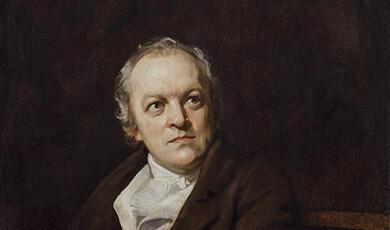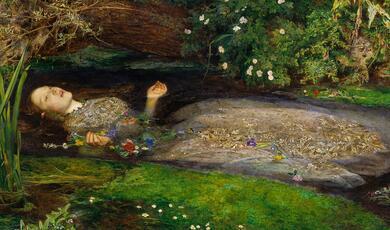Endings in the Novel, from Austen and Dickens to Edward St Aubyn and Rachel Cusk
Share
- Details
- Text
- Audio
- Downloads
- Extra Reading
More than anything else, the end matters to the novel reader. Novelists, including Austen and Dickens, sometimes changed their minds about their endings, using these changes of mind to explore how an ending satisfies, or fails to satisfy, our expectations.
The lecture will explore the rise of the indeterminate ending, from Henry James on. And it will suggest how an ending can, for worse as well as for better, retrospectively change our experience of a novel.
Download Text
Endings in the Novel, from Austen and Dickens to Edward St Aubyn and Rachel Cusk
Professor John Mullan
5th April 2023
My previous lecture on historical fiction ended with an ending.
Beneath him the ground upheaves. The river tugs him; he looks for the quick-moving pattern, for the flitting, liquid scarlet. Between a pulse-beat and the next he shifts, going out on crimson with the tide of his inner sea. He is far from England now, far from these islands, from the waters salt and fresh. He has vanished; he is the slippery stones underfoot, he is the last faint ripple in the wake of himself. He feels for an opening, blinded, looking for a door: tracking the light along the wall.
Hilary Mantel, The Mirror and the Light (2020), Part Six, II
The force of Mantel’s ending to the third of her Thomas Cromwell novels was that we always knew where we were heading – how the last novel must end. As everything in the novels is narrated from Thomas Cromwell’s point of view, history determines the ending.
There is a special pressure upon the ending with a novel sequence – what the French call a roman fleuve. The reader will have come a long way with the author. But it has to be clear that there will be no more!
Some of you will remember the speculation before the publication of the seventh and last Harry Potter book, Harry Potter and the Deathly Hallows (2007), about how J.K. Rowling would bring her sequence to its end.
Here is the ending of Edward St Aubyn’s semi-autobiographical sequence of five novels centred on his alter ego Patrick Melrose. It began with Never Mind in 1992.
This novel recalled and turned into fiction his monstrous father, who raped him when he was a child and continued abusing him for years.
It ends in 2011 with the fifth book in the series, emphatically and sardonically entitled At Last. The events span a single day, which begins with his mother’s funeral and ends with the news, in a telephone call, that his father’s venomous friend Nicholas Pratt has suddenly died.
At the end of the previous chapter, Mary, his ex-wife has invited him for supper with her and his children. He has declined and she has told him that he can always change his mind.
‘In fact,’ said Thomas, ‘you should change your mind, because that’s what it’s for!’
Patrick slid back down in his chair and sprawled in front of the view. He noticed how his tears cooled as they ran down his cheeks. Washed eyes and a tired and empty feeling. Was that what other people meant by peaceful? There must be more to it than that, but he didn’t claim to be an expert. He suddenly wanted to see his children, real children, not the ghosts of their ancestors’ childhoods, real children with a reasonable chance of enjoying their lives. He picked up the phone and dialled Mary’s number. He was going to change his mind. After all, that’s what Thomas said it was for.
Edward St Aubyn, At Last (2011), Ch. 14
Good to end on a child’s dry wit.
In 2014, 2016 and 2018, Rachel Cusk published a sequence of three novels, Outline, Transit and Kudos, all narrated by an un-self-revealing character called Faye. She listens to and reports the self-absorbed monologues of the characters she meets.
Each of these gripping yet entirely plotless novels could go on forever – so each has to be brought to an end.
The second volume ends with a brilliantly ghastly supper party at a house in the country where the narrator is staying with her cousin Lawrence. He has recently and rancorously divorced and now has a new partner, Eloise, who has two sons from a previous relationship. They are whining and demanding at supper, and Lawrence becomes irritable and tyrannical.
Eloise confides to one of the supper guests that the younger son who tries to get into bed with her every night, but Lawrence refuses to let him, so Eloise and he watch television until he falls asleep.
Early next morning, while it is still dark, she gets up to leave. Going downstairs, she sees a blue light flickering through a half-open door.
I heard the murmur of the television and saw a shape flit briefly across the gap. I recognised Eloise’s silhouette, caught a glimpse of her filmy nightgown and her swift bare foot. Through the windows a strange subterranean light was rising, barely distinguishable from darkness. I felt change far beneath me, moving deep beneath the surface of things, like the plates of the earth blindly moving in their black traces. I found my bag and my car keys and let myself silently out of the house.
Rachel Cusk, Transit (2016)
You will notice something odd about this, in comparison to the Mantel passage. The font. It is a sans serif font called Optima, used for each of the novels in the series. The novel is graphically indicating the unexpressiveness, the unsettling neutrality of the narration.
Under the calm of the narration is tumult.
The admittedly unsettling ending to the final volume, Kudos, seems contrived in comparison.
Our narrator has travelled to a literary conference in an unnamed Mediterranean country. Here she listens to the near soliloquies of fellow writers and journalists. The men talk about themselves; the women talk about the men. Taking a break from the literary self-obsession, she goes to the beach for a swim. All the other people on the beach seem to be men, many of them naked. As she is swimming, ‘a huge burly man with a great curling black beard and a rounded stomach and thighs like hams’ walks towards her.
He came to a halt just where the waves broke and he stood there in his nakedness like a deity, resplendent and grinning. Then he grasped his thick penis and began to urinate into the water. The flow came out so abundantly that it made a fat, glittering jet, like a rope of gold he was casting into the sea. He looked at me with black eyes full of malevolent delight while the golden jet poured unceasingly forth from him until it seemed impossible that he could contain any more. The water bore me up, heaving, as if I lay on the breast of some sighing creature while the man emptied himself into its depths. I looked into his cruel, merry eyes, and I waited for him to stop.
Rachel Cusk, Kudos (2018)
The ending makes the reader consider how much of the trilogy that has preceded this passage is about the more or less malevolent exercise of masculine power.
What is an ending?
Look at Franz Kafka’s The Trial. Kafka never finished the novel. He left an assortment of unnumbered manuscript chapters in separate folders when he died. It was still a work in progress. But he had written the final chapter, ‘Ende’, apparenly drafted quite early in the composition process.
Two men, perhaps officials, call for our protagonist, Josef K., and tell him that he must accompany them. They walk him out of the city, into the countryside, and it becomes clear that they are going to kill him.
But the hands of one of the men were already at K.’s throat, while the other thrust the knife deep into his heart and twisted it there, twice. With failing eyes, K. saw the two of them, cheek by cheek, close in front of his face, watching the final act. ‘Like a dog!’ he said: it was as if the shame of it would outlive him.
Franz Kafka, The Trial, ‘The End’
Aber an K.s Gurgel legten sich die Hände des einen Herrn, während der andere das Messer ihm tief ins Herz stieß und zweimal dort drehte. Mit brechenden Augen sah noch K., wie die Herren, nahe vor seinem Gesicht, Wange an Wange aneinandergelehnt, die Entscheidung beobachteten. »Wie ein Hund!« sagte er, es war, als sollte die Scham ihn überleben.
Franz Kafka, Der Prozeß, ‘Ende’ (1925)
Unfinished certainly, but there is no doubt that the novel was ended, at the monet of the protagonist’s death. But not just this. The clinching perception that, as a victim, his is the shame. The mysterious bureaucracy’s final triumph is to let him realise that he is to blame.
The ending of a novel matters very much to the reader. It is where the contract is fulfilled. It is where promises have to be kept, clues unravelled, questions answered. Or it is where these things do not happen.
A botched ending can change what we thought we thought of all that went before. Like Larkin’s ‘failure spreading back up the arm’.
We can see the importance of an ending to fulfilling all that went before when a novelist changes his or her mind.
Take Jane Austen’s Persuasion, a novel that the novelist finished twice. Here is the first sheet of the manuscript of Austen’s original ending, the final two chapters as she first conceived them. (It is also the only ms we have of any of Austen’s six completed novels.)
Admiral Croft inveigles Anne Elliot into his lodgings, supposedly to see his wife, but in fact because he knows that Captain Wentworth is there. He then leaves then together. Captain Wentworth tells her that Admiral Croft has been told that she is engaged to Mr Elliot. Which gives her a chance to deny it, vehemently.
He was a moment silent.—She turned her eyes toward him for the first time since his re-entering the room. His colour was varying—& he was looking at her with all the Power & Keenness, which she beleived no other eyes than his, possessed. “No Truth in any such report!”—he repeated.—“No Truth in any part of it?”—“None.”—He had been standing by a chair—enjoying the releif of leaning on it—or of playing with it;—he now sat down—drew it a little nearer to her—& looked, with an expression which had something more than penetration in it, something softer;—Her Countenance did not discourage.—It was a silent, but a very powerful Dialogue;—on his side, Supplication, on her’s acceptance.—Still a little nearer—and a hand taken and pressed—and “Anne, my own dear Anne!”—bursting forth in the fullness of exquisite feeling—and all Suspense & Indecision were over.—They were re-united. They were restored to all that had been lost.
On the final page of Chapter 11, she marked ‘Finish July 18, 1816’.
She surely saw what was wrong with that first ending – the failure spreading up the arm. It relied on Admiral Croft, the most honest and open of men, suddenly becoming surreptitious. It involved Captain Wentworth suddenly gushing out with Anne’s first name. It was at once wordy and perfunctory.
So she had second thoughts. Austen rewrote the ending at some point between July 18-August 6, 1816. According to her nephew Edward Austen-Leigh, she had thought the original ending ‘tame and flat’. She produced something brilliant instead.
In a crowded room in the White Hart inn in Bath, Anne discusses with Captain Harville whether a a man’s or a woman’s feelings are likely to last the longest. They have recently heard that Captain Benwick, who was in mourning for the death of his fiancée, Harville’s sister, has become engaged to Louisa Musgrove. As they talk, Captain Wentworth sits writing at a desk nearby. As he rises to leave, he pushes a letter, evidently for Anne, towards her.
It announces …
“… For you alone, I think and plan. Have you not seen this? Can you fail to have understood my wishes? I had not waited even these ten days, could I have read your feelings, as I think you must have penetrated mine. I can hardly write. I am every instant hearing something which overpowers me. You sink your voice, but I can distinguish the tones of that voice when they would be lost on others. Too good, too excellent creature! You do us justice, indeed. You do believe that there is true attachment and constancy among men. Believe it to be most fervent, most undeviating, in
F. W.
“I must go, uncertain of my fate; but I shall return hither, or follow your party, as soon as possible. A word, a look, will be enough to decide whether I enter your father’s house this evening or never.”
Austen altered the how of her ending, but she was never in doubt (not is the reader) about the where of the ending.
Later novelists will entertain doubts. Here is the ending of Charlotte Brontë’s final novel, Villette.
Lucy Snowe, the heroine and narrator, has finally found love with Monsieur Paul Emanuel, her fellow teacher at the girl’s school in Villette (Brussels) where she used to work. They have declared their love to each other, but he has had to travel to Guadeloupe for three years. Now he is to return to marry her, but, as he sails back, a tempest rages in the Atlantic
That storm roared frenzied, for seven days. It did not cease till the Atlantic was strewn with wrecks: it did not lull till the deeps had gorged their full of sustenance. Not till the destroying angel of tempest had achieved his perfect work, would he fold the wings whose waft was thunder—the tremor of whose plumes was storm.
Peace, be still! Oh! a thousand weepers, praying in agony on waiting shores, listened for that voice, but it was not uttered—not uttered till; when the hush came, some could not feel it: till, when the sun returned, his light was night to some!
Here pause: pause at once. There is enough said. Trouble no quiet, kind heart; leave sunny imaginations hope. Let it be theirs to conceive the delight of joy born again fresh out of great terror, the rapture of rescue from peril, the wondrous reprieve from dread, the fruition of return. Let them picture union and a happy succeeding life.
Madame Beck prospered all the days of her life; so did Père Silas; Madame Walravens fulfilled her ninetieth year before she died. Farewell.
Those three characters who prosper are those who have conspired to try to thwart Lucy’s relationship with Paul Emmanuel.
Brontë’s friend Elizabeth Gaskell recalled the novelist telling her that she had made the ending uncertain to placate her father.
‘Mr. Brontë was anxious that [Villette] should end well, as he disliked novels which left a melancholy impression upon the mind’.
Having decided that Paul Emanuel would die at sea, all that Charlotte Brontë ‘could do in compliance with her father’s wish was so to veil the fate in oracular words as to leave it to the character and discernment of her readers to interpret her meaning’. The Life of Charlotte Brontë.
It has since felt to many readers like a kind of failure of nerve – a final un-Brontë-like bending to Victorian convention.
But an ending has to work within convention, of course. Here is one that does so, whilst preserving just a hint of ambiguity.
Now in his 30s, Pip returns to the grounds of Miss Havisham’s demolished home, Satis House, where he encounters the woman to whom he lost his heart, Estella. He has heard that her brutish husband, Bentley Drummle, is dead. She is a widow. They are both older, wiser, melancholy. Their meeting in the dusk is a reconciliation, as they look back to the past.
“But you said to me,” returned Estella, very earnestly, “‘God bless you, God forgive you!’ And if you could say that to me then, you will not hesitate to say that to me now,—now, when suffering has been stronger than all other teaching, and has taught me to understand what your heart used to be. I have been bent and broken, but—I hope—into a better shape. Be as considerate and good to me as you were, and tell me we are friends.”
“We are friends,” said I, rising and bending over her, as she rose from the bench.
“And will continue friends apart,” said Estella.
I took her hand in mine, and we went out of the ruined place; and, as the morning mists had risen long ago when I first left the forge, so the evening mists were rising now, and in all the broad expanse of tranquil light they showed to me, I saw no shadow of another parting from her.
Charles Dickens, Great Expectations (1861-2), Ch. LIX
Is this a happy ending? Something like it.
It is certainly nearer a happy ending than what Dickens originally wrote. In the original ending, Drummle is dead by Estella has remarried – a Shropshire doctor (you can’t get more blameless than that). She is not available. Pip meets her again in the street in London. She is in a carriage; he is accompanied by a child – little Pip, the son of Joe Gargery and Biddy (the woman Pip could have married).
‘I am greatly changed, I know; but I thought you would like to shake hands with Estella, too, Pip. Lift up that pretty child and let me kiss it!’ (She supposed the child, I think, to be my child.)
I was very glad afterwards to have had the interview; for, in her face and in her voice, and in her touch, she gave me the assurance, that suffering had been stronger than Miss Havisham’s teaching, and had given her a heart to understand what my heart used to be.
Charles Dickens, cancelled ms ending to Great Expectations
It is a brilliantly melancholy ending, with Dickens – and Pip – allowing Estella to part on the mistake of thinking that Pip has a child.
Dickens’s friend Bulwer Lytton saw this and persuaded him that his readers would be outraged. He must change it. Dickens was persuaded to comply. ‘I have done it in as few words as possible’. We can feel his reluctance in the coincidence on which he made his new ending depend. How come Pip bumps into Estella on his only visit to Satis House in 11 years?
“After so many years, it is strange that we should thus meet again, Estella, here where our first meeting was! Do you often come back?”
“I have never been here since.”
Great Expectations, Ch. LIX
If you have watched film or TV adaptations of Great Expectations, you will know that they always change the ending. [examples?]
I cannot tell you how the new, 6-part BBC dramatization – adaptation, really – of Great Expectations is going to end. I really wish I could. I do know. And I can confide that it is yet another new ending to the story.
Later novelists would mock Victorian expectations about how a novel should end. Here is a piece of such mockery, from someone who has seemed to many to be the first ‘modern’ novelist writing in English.
One would say that being good means representing virtuous and aspiring characters, placed in prominent positions; another would say that it depends for a ‘happy ending’ on a distribution at the last of prizes, pensions, husbands, wives, babies, millions, appended paragraphs and cheerful remarks.
Henry James, ‘The Art of Fiction’ (1884)
Yet a novelist might specialise in ‘happy endings’ whilst still undermining any thought that a novel’s ending would ever teach all the right lessons.
To begin perfect happiness at the respective ages of twenty-six and eighteen is to do pretty well; and professing myself moreover convinced that the General’s unjust interference, so far from being really injurious to their felicity, was perhaps rather conducive to it, by improving their knowledge of each other, and adding strength to their attachment, I leave it to be settled, by whomsoever it may concern, whether the tendency of this work be altogether to recommend parental tyranny, or reward filial disobedience.
Jane Austen, Northanger Abbey, II Ch. XVI
Henry James himself thought a great deal about endings and became the pioneer of what we have come to call the indeterminate ending.
Perhaps the most famous example is from his most famous novel, The Portrait of a Lady.
Here is the ending of the novel as it appeared, in its initial serialisation in 1881, and in the one-volume edition of 1882. Isabel Archer is married to the sadistic Gilbert Osmond. Against his wishes, she leaves their home in Italy to travel to England, where her old friend Ralph Touchett is dying. After Ralph’s death, her former suitor, Caspar Goodwood meets her at Ralph’s house and tells her he still loves her. He begs her to leave her husband for him. They kiss, but then she flees. The next day, Caspar goes to London to find her, but her friend Henrietta tells him that he is too late.
“She came here yesterday, and spent the night. But this morning she started for Rome.”
Caspar Goodwood was not looking at her; his eyes were fastened on the doorstep. “Oh, she started—” he stammered. And without finishing his phrase, or looking up, he turned away.
Henrietta had come out, closing the door behind her, and now she put out her hand and grasped his arm.
“Look here, Mr. Goodwood,” she said; “just you wait!”
On which he looked up at her.
But evidently this was indeterminate in the wrong way. At least one contemporary review took it that this was meant to imply that Isabel would leave her husband for Goodwood. When Henry James revised the novel for his New York Edition of 1908, he rewrote this ending to make it, as it were, more determinately indeterminate.
“She came here yesterday, and spent the night. But this morning she started for Rome.”
Caspar Goodwood was not looking at her; his eyes were fastened on the doorstep. “Oh, she started—?” he stammered. And without finishing his phrase or looking up he stiffly averted himself. But he couldn’t otherwise move.
Henrietta had come out, closing the door behind her, and now she put out her hand and grasped his arm.
“Look here, Mr. Goodwood,” she said; “just you wait!”
On which he looked up at her—but only to guess, from her face, with a revulsion, that she simply meant he was young. She stood shining at him with that cheap comfort, and it added, on the spot, thirty years to his life. She walked him away with her, however, as if she had given him now the key to patience.
Henry James, The Portrait of a Lady (rev. New York Edition, 1908), Ch. LV
This is a tough ending. Adaptations can never stomach it. Even Jane Campion’s often engrossing film adaptation flinches away. Isabel kisses Caspar in the garden of …, runs back to the house – then stops and looks back to Caspar in the garden.
Not what Henry James wanted!
The most artistically self-conscious of novelists, James was of course entirely conscious of what he was doing. Here is what he says about the ending of The Portrait of a Lady in his Notebooks.
The obvious criticism of course will be that it is not finished — that I have not seen the heroine to the end of her situation — that I have left her en l'air. — This is both true and false. The whole of anything is never told; you can only take what groups together. What I have done has that unity — it groups together. It is complete in itself — and the rest may be taken up or not, later.
There are plenty of literary examples of novelists who, inspirited by the success of a given novel, did ‘take up’ the rest later.
Daniel Defoe followed Robinson Crusoe with The Further Adventures of Robinson Crusoe; Samuel Richardson gave the fans of his bestselling novel Pamela the almost unreadable Pamela … In her Exalted Condition; Robert Louis Stevenson returned to the characters of Kidnapped with Catriona. Recently, of course, Margaret Atwood – after a gap of 34 years – has given us The Testaments (2019), a sequel to The Handmaid’s Tale (1985).
One can’t imagine that Henry James ever seriously considered ‘taking up’ again the characters of The Portrait of a Lady and their predicaments. However, 137 years later, the novelist John Banville did so for him in his 2018 novel Mrs Osmond.
If the modern novel gave us the indeterminate ending, the post-modern novel gave us alternative endings.
Here is an early and hugely influential example, John Fowles’s The French Lieutenant’s Woman (1969).
The gentleman naturalist Charles Smithson is engaged to the conventional heiress Ernestina Freeman, but falls for a supposedly fallen woman, Sarah Woodruff.
The French Lieutenant’s Woman actually has three endings, though the first is perfunctory and clearly does not interest the novelist. In this Charles ignores Sarah’s request for a meeting in Exeter and returns to Lyme to explain himself to Ernestina, whom he duly marries.
But then, the novelist appears in the railway carriage opposite Charles and has to decide what else to do with him
‘But the conventions of Victorian fiction allow, allowed no place for the open, the inconclusive ending; and I preached earlier of the freedom characters must be given’ (Ch. 55)
So, what would count as an ending.
… I continue to stare at Charles and see no reason this time for fixing the fight upon which he is about to engage. That leaves me with two alternatives. I let the fight proceed and take no more than a recording part in it; or I take both sides in it. I stare at that vaguely effete but not completely futile face. And as we near London, I think I see a solution; that is, I see the dilemma is false. The only way I can take no part in the fight is to show two versions of it. That leaves me with only one problem: I cannot give both versions at once, yet whichever is the second will seem, so strong is the tyranny of the last chapter, the final, the ‘real’ version.
I take my purse from the pocket of my frock coat, I extract a florin, I rest it on my right thumbnail, I flick it, spinning, two feet into the air and catch it in my left hand.
So be it. And I am suddenly aware that Charles has opened his eyes and is looking at me.
Then we get the two endings.
In both, Charles and Sarah consummated their love.
In the first version, after years wandering in first Europe then America. Charles tracks Sarah down in London, where she is employed as a secretary and model by an unnamed pre-Raphaelite (who is clearly Dante Gabriel Rossetti). He is about to leave, but is introduced to a small girl, who, we gradually realize, is his daughter. As he realizes this too, he and Sarah are finally brought together.
But then the novelist appears outside the house, and winds his watch back fifteen minutes to give us a different ending.
Now we have to the same encounter in the affluent bohemian home in Chelsea. But this time Charles’s anger and resentment predominate, while Sarah tells him that she can never now give herself to any man. Charles leaves, thoroughly chastened man, failing to recognize the small girl he glimpses as his daughter.
Those of you who have seen the 2016 film La La Land will know the narrative trick.
Here it is in a different version, in Ian McEwan’s 2001 novel Atonement.
Briony Tallis has given false testimony that has ensured the conviction of Robbie, her sister Cecilia’s lover, for a rape that he did not commit. It is 1940. Robbie has been released early from prison to join the British Army in Northern France. He has been evacuated from Dunkirk and is staying with Cecilia in Balham. Briony meets them to express her guilt and to tell them that she will write a legal letter confessing what she has done.
She knew what was required of her. Not simply a letter, but a new draft, an atonement, and she was ready to begin.
BT - London 1999
Yet there is a thickness of pages between you and the back cover. However strongly signalled (the use of the title, the statement of a new beginning), can this be the ending?
You turn the page and you get this, a heading alone on the page.
London, 1999
You turn another page, and this.
What a strange time this has been. Today, on the morning of my seventy-seventh birthday, I decided to make one last visit to the Imperial War Museum library in Lambeth. It suited my peculiar state of mind.
From third- to first-person narration. From the early 1940s to the end of the century.
Then you realise that BT stands for Briony Tallis, the novel’s central character, and that the date and the initials mean that the rest of the novel has been written not, as you first supposed, by Ian McEwan – but by Briony Tallis. The character is the author. She has written the novel as her ‘atonement’ – to make up in fiction for what has not happened in life. To give us, we might say, a happy ending.
Atonement begins with a lengthy epigraph from Northanger Abbey, a novel equally self-conscious about how fiction can fulfil where life usually disappoints. The trick of McEwan’s false ending reverses Austen’s trick at the ending of her novel.
The anxiety, which in this state of their attachment must be the portion of Henry and Catherine, and of all who loved either, as to its final event, can hardly extend, I fear, to the bosom of my readers, who will see in the tell–tale compression of the pages before them, that we are all hastening together to perfect felicity.
Jane Austen, Northanger Abbey (1818), II xvi
How should we end?
I ended the first of these lectures with a passage from the ending of a novel. It was from Kazuo Ishiguro’s Never Let Me Go.
Here is the narrator, Kathy H …
I was thinking about the rubbish, the flapping plastic in the branches, the shore-line of odd stuff caught along the fencing, and I half-closed my eyes and imagined this was the spot where everything I’d ever lost since my childhood had washed up, and I was now standing here in front of it, and if I waited long enough, a tiny figure would appear on the horizon across the field, and gradually get larger until I’d see it was Tommy, and he’d wave, maybe even call. The fantasy never got beyond that—I didn’t let it—and though the tears rolled down my face, I wasn’t sobbing or out of control. I just waited a bit, then turned back to the car, to drive off to wherever it was I was supposed to be.
Kazuo Ishiguro, Never Let Me Go (2005), Ch. Twenty-Three
That last sentence, in all the resonance of its colloquial ordinariness, is as good an ending of a 21st-C. novel as any I know. How simply it fulfils all that has gone before. And how well it shows that an unhappy ending can be as satisfying as a happy ending.
© Professor Mullan 2023
Part of:
This event was on Wed, 05 Apr 2023
Support Gresham
Gresham College has offered an outstanding education to the public free of charge for over 400 years. Today, Gresham College plays an important role in fostering a love of learning and a greater understanding of ourselves and the world around us. Your donation will help to widen our reach and to broaden our audience, allowing more people to benefit from a high-quality education from some of the brightest minds.


 Login
Login







